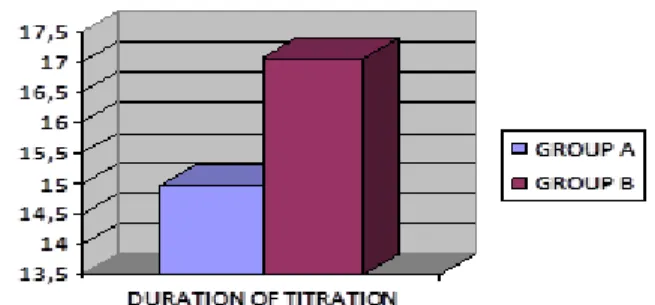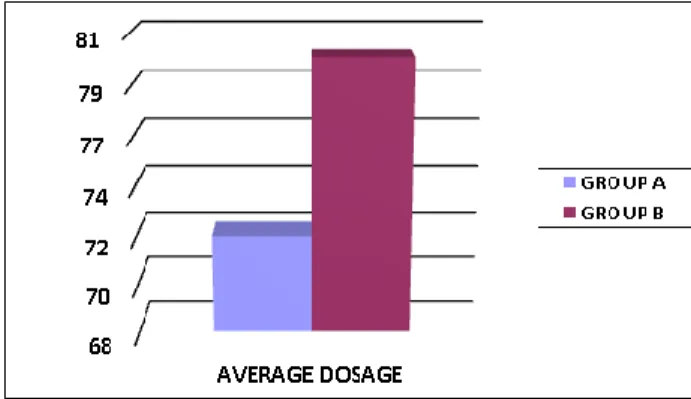COMBINED ADMINISTRATION OF OXYCODONE/NALOXONE IN
CHRONIC OSTEO-ARTICULAR DISEASES PAIN THERAPY
Palomba Rosa
1, Miralto Federica
1, Vinciguerra Annamaria
1, Salvato Fabiana
1, Vaccarella Anna
1 1Department of Anesthesia, Rianimation, Intensive Therapy and Pain Therapy University “Federico II” Naples, Italy.
Corresponding author: Palomba Rosa - e-mail: [email protected]
Abstract - The aim of this study is the analysis of the
beneficial impact of using opioid receptor antagonist associated to opioid analgesic on the quality of life in patients suffering from chronic non-cancer pain.
We recruited 60 patients suffering from osteo-articular diseases who were randomized into two groups of treatment. The group A was treated with the association of opioid receptor antagonist and opioid agonist, represented by Oxycodone. The group B was treated with the opioid analgesics Oxycodone, transdermal Fentanil, and Hidromorphone, without the opioid antagonist. The end-points assessed were the duration of titration, the average reached dosage, the duration of the stability of dosage and the opioid–induced constipation (OIC) using the BFI.
Key words: oxycodone/naloxone, chronic pain, chronic osteo-articular diseases
I. INTRODUCTION
Several studies demonstrated the analgesic efficacy of using long-term opioids for chronic non-cancer pain. In these years, in fact, the opioid treatment of benign diseases, such as osteo-articular diseases, burdened with moderate to severe chronic pain, increased. Use of opioid analgesics, with or without paracetamol, is useful especially in patients in whom NSAIDs are contraindicated, ineffective, and/or poorly tolerated [1].
The analgesic effect of opioids is mediated by the binding to specific receptors in the central nervous system. The binding of opioids to receptors in the gastro-intestinal tract, instead, is responsible for the main side
effects reported by patients such as abdominal distension, incomplete evacuation, gastro-oesophageal reflux and especially induced constipation (OIC). The opioid-induced constipation unlike other effects, does not undergo tolerance and therefore it has a significant effect on the patient’s quality of life. The treatment of OIC with laxatives is nonspecific and often unsuccessful.
Recently, it has been demonstrated that the prevalence of constipation reached 63.5% in patients treated with opioids. Since 89,5% of these patients does not take advantage of laxatives administration, the author suggests that the best strategy is prevention [2].
The prevention of the OIC can be obtained by administrating opioid receptor antagonists that act at the GI level, without interfering with analgesia. These objectives can be achieved with the use of naloxone, which has low bioavailability after oral administration, equivalent to 3%, acting almost exclusively on GI receptors. Naloxone is commercially available as a single entity, in intravenous (IV) dosage form, which is indicated for the blockade of exogenously administered opioids. In the oral dosage form, Naloxone is available only in the combined formulation with the Oxycodone, in the ratio of 1:2 [3]. Thanks to this association, the drug is able to produce the analgesic effect determined by the action of oxycodone on µ- and κ-receptors, and of naloxone as antagonist of the opioids receptors only at GI level. This prevents and fights the onset of opioid-induced constipation without reducing the analgesic effect of oxycodone [4].
Wang and collaborators demonstrated that the use of Naloxone in low doses can alleviate opioid tolerance, with mechanisms not yet completely defined, that probably reside in the switch of the μ-receptor G-protein-associated or in activating adenylate cyclase. This
additional effect would influence the effective dose of the agonist opioid and the time within this dose is steady [5].
II. METHODS
Our research was authorized by Ethic Committee of University Federico II. In this study we recruited 60 patients (age 59-73) suffering from chronic osteo-articular diseases in stable condition, with pain assessment using visual analogic scale (VAS) of 7 or more; we excluded patients with serious organ failure, history of alcoholism or drug addiction, cognitive impairment. All the patients where asked to consent to the use of personal data. The patients were randomized into two treatment groups: the Group A (31 patients) took the combination oxycodone/naloxone with paracetamol in cyclic administration; the Group B (29 patients) took other opioid analgesics (6 pz fentanyl transdermal, 13 pz hydromorphone, 10 pz oxycodone) with paracetamol in cyclic administration. The effects of the combination of opioid antagonist and agonist were evaluated in terms of:
•
Duration of the titration;•
Average reached dosage, expressed in a relation with an equivalent dosage of morphine;•
Duration of the stability of dosage;•
Incidence of OIC through the administration of the BFI, a questionnaire relating to bowel function estimated on the basis of 3 items: difficulties in the evacuation (0-100; 0 = no difficulty, 100 = severe difficulty), sensation of incomplete evacuation (0-100, 0 = absent, 100 = very strong), personal evaluation of constipation (0-100, 0 = none, 100 = very stubborn). The BFI was evaluated at enrollment in the study (T1), at 1 month (T2), and at the end of follow-up (T3). The results obtained in the two different groups were compared with T test, in which α=0.05.III. RESULTS
Fixed endpoints were evaluated for both treatment groups.
Titration had an average duration of 14.97 days ± 6.01 in Group A and 17.07 days ± 5.11 in Group B (fig.
1).
The reached average dosage was compared by converting the dosage of the opioid in the equivalent dosage of morphine, through the use of equianalgesia
tables. This comparison shows that in Group A the mean dose achieved, expressed as mg of morphine, is equal to 72 ± 13.22, while in Group B the mean dose achieved is 80 (fig.2).
The shelf life of an effective dose was found to be 77.03 days ± 8.02 for Group A and 58.38 days ± 4.55 for group B (fig.3).. The patients of Group B needed a drug increase in a shorter time to control the pain.
The opioid-induced constipation, estimated by administration of the BFI, was assessed at enrollment in the study (T1), at 1 month (T2), and at the end of follow-up (T3). At enrollment (T1) the values of BFI were on average of 46.35 ± 3.14 for the Group A and 66.17 ± 6.41 for the Group B. At 1 month (T2) BFI was increased just to 50.84 ± 4.14 for the group A, while it raised up to 77.22 ± 4.58 for the Group B. At the term of follow-up (T3) BFI decreased to 46.42 ± 5.40 in the Group A, while it increased, although barely, to 79.59 ± 5.09 in the Group B (fig.4).
IV. DISCUSSION
The results of the study show that a therapy based on the association of an opioid receptor antagonist, such as naloxone, with opioid analgesics, provides a number of advantages. These benefits are reflected in a positive way on patients’ quality of life.
Fig. 2: Average dosage
Fig. 3: Shelf-life of an effective dose
Fig. 4: BFI during the follow-up
The use of naloxone in the group A is associated with a lower temporal extension of the titration, towards a dosage with analgesic efficacy and an average dosage expressed in terms of analgesic equivalence with morphine; this analgesic efficacy is lower than that recorded in group B, treated with opioid analgesics without the antagonist. Analgesic efficacy was considered good when the score was <6 in the visual analog scale of pain relief. Moreover, the dosage is stable for a greater time range. This results in better adherence to therapy and
increased patient satisfaction, key elements in the treatment of chronic benign diseases. These results can be attributed to the role of the antagonist in the inhibition of opioid tolerance, already shown by experimental studies on animals [6] [7].
According to data, already available in the literature, Naloxone has proven useful in breaking the opioid-induced constipation, with a clear improvement of bowel function without any interference with the analgesic efficacy [8] [9].
V. CONCLUSIONS
The results obtained from the study show that the combination oxycodone-naloxone allows for greater stability in the maintenance of dosing, once you find a suitable dose for each patient, as well as it increased quality of life, as indicated by the best BFI index values obtained in the group A.
REFERENCES
[1] Jordan KM, Arden NK, Doherty M, Bannwarth B, Bijlsma JW, Dieppe P, et al. EULAR Recommendations 2003: an evidence based approach to the management of knee osteoarthritis: Report of a Task Force of the Standing Committee for International Clinical Studies Including Therapeutic Trials (ESCISIT)
[2] Holzer P. Opioid receptors in the gastrointestinal tract. Regul Pept 2009;155:11–17.
[3] Smith K, Hopp M, Mundin G, Bond S, Bailey P, Woodward J, Bell D. Low absolute bioavailability of oral naloxone in healthy subjects. Int J Clin Pharmacol Ther. 2012;50(5):360-367
[4] Targin. Riassunto delle Caratteristiche del Prodotto (RCP)
[5] Wang HY, Friedman E, Olmstead MC, Burns LH. Ultra-low-dose naloxone suppresses opioid tolerance, dependence and associated changes in mu opioid receptor-G protein coupling and Gbetagamma signaling. Neuroscience. 2005;135(1):247-261.
[6] Abul-Husn NS, Sutak M, Milne B, Jhamandas K. Augmentation of spinal morphine analgesia and inhibition of tolerance by low doses of μ- and δ-opioid receptor antagonists Br J Pharmacol. 2007;151(6):877–887
[7] McNaull B, Trang T, Sutak M, Jhamandas K. Inhibition of tolerance to spinal morphine antinociception by low doses of opioid receptor antagonists. Eur J Pharmacol. 2007;560(2-3):132-141.
[8] Löwenstein O, Leyendecker P, Hopp M, Schutter U, Rogers PD, Uhl R, et al. Combined prolonged-release oxycodone/naloxone improves bowel function in patients receiving opioids for moderate to severe non malignant chronic pain: a randomised controlled trial. Expert Opin Pharmacother. 2009;10(4):531-543
[9] Simpson K, Leyendecker P, Hopp M, Müller-Lissner S, Löwenstein O, De Andrés J, et al. Fixed-ratio combination oxycodone/naloxone compared with oxycodone alone for the relief of opioid-induced constipation in moderate-to-severe noncancer pain Curr Med Res Opin. 2008; 24(12):3503-3512.

